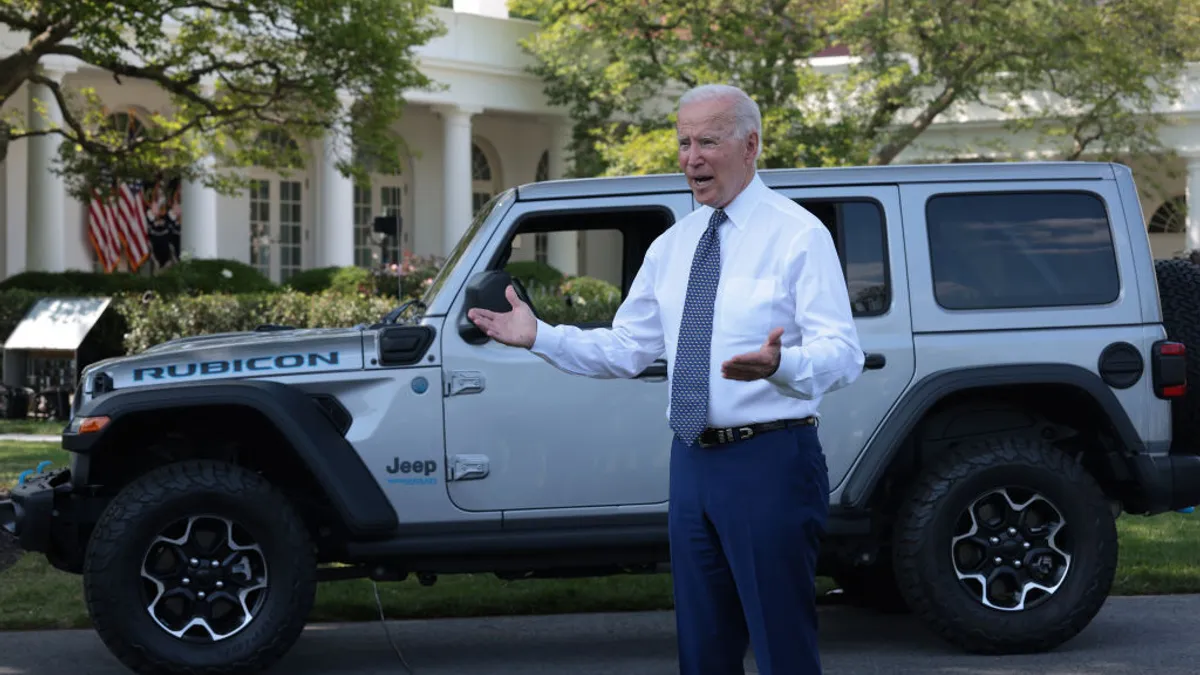Dive Brief:
- The federal government could save more than $1 billion by replacing nearly all of its light-duty vehicles and buses with electric vehicles (EVs) by the end of the decade, according to a new report from Atlas Public Policy released Wednesday by the Electrification Coalition.
- The report finds that by 2025, up to 40% of the 315,000 gas-powered light-duty vehicles and buses the U.S. government owns (excluding those the U.S. Postal Service owns) could be replaced by EVs at a lower total cost of ownership. By 2030, that number rises to 97%.
- The Postal Service (USPS), which operates the largest fleet of any agency, could see even greater savings. By 2025, it would be cheaper to use an EV for more than 99% of the service's fleet, for a savings of $2.9 billion over the life of the vehicles.
Dive Insight:
President Joe Biden signed an executive order in January that, in part, directed federal agencies to “procure carbon pollution-free electricity and clean, zero-emission vehicles,” a goal experts said could provide a boost to the EV market because of the government’s purchasing power and influence. In August, Biden set a separate goal to make half of all new vehicles sold in 2030 zero-emissions vehicles.
“The federal fleet provides a unique and important opportunity, as one of the largest fleets in the country, to help prioritize the market and encourage transportation electrification to happen much more quickly,” said Electrification Coalition Executive Director Ben Prochazka in a briefing Wednesday. Fleets are appealing for electrification because they provide a steady market, centralized management, predictable use patterns and visibility among the public, Prochazka added.
The Atlas Public Policy report found that the transition makes financial sense, especially when considering the full lifetime cost of the vehicle. Using the total cost of ownership (TCO) metric — which includes factors like fuel costs, maintenance and the sustainability savings — the report found that the government could see significant savings by electrifying despite the higher upfront cost. With up to 40% of the fleet (mostly mid-size and large passenger vehicles) able to transition at a lower cost by 2025, the savings could be $316 million. That rises to $1.18 billion by 2030 as the analysis expects the cost of EVs will drop and more charging infrastructure will become available.
Considering the installation of new charging equipment and the lifetime savings in fuel and maintenance, study co-author Nick Nigro said those savings would grow more the faster the fleet started its transition. That, however, could require a shift in thinking for federal operators, who are typically more concerned with the upfront capital.
“The time to electrify the federal fleet is now, for sure,” said Nigro, the founder of Atlas. “That is clear from the numbers.”
By 2030, electrifying vehicles in the non-USPS fleet where the TCO is competitive with gas vehicles would reduce 7.6 million metric tons of carbon dioxide equivalent over the life of the vehicles, along with reductions in particular matter and nitrogen oxide pollution.
The report considers USPS separately because of the size of its fleet. It found that affordable alternatives to the gas-powered mail trucks already exist, which would make it easy for USPS to start turning over its long-life fleet for cost and pollution reductions. USPS announced a plan this year to make 10% of its new fleet of up to 165,000 trucks electric, which many advocates said was far below the level needed. House Democrats have proposed $8 billion in the Postal Service’s next funding bill for the purchase of more EVs, with a requirement that at least 75% of the fleet be electric.
The $1 trillion infrastructure bill the Senate passed includes $7.5 billion for EV charging stations. Twenty-eight House Democrats sent a letter to their leadership calling for an additional $85 billion for chargers in the $3.5 trillion budget reconciliation package under consideration.
Meanwhile, cities have taken their own steps to electrify their fleets. New York City Mayor Bill de Blasio signed an ordinance in 2020 to electrify the city’s municipal fleet — comprising 30,000 owned and leased vehicles — by 2040. Seattle has a goal of electrifying its city fleet by 2030, and Boston set a goal of electrifying municipal light-duty vehicles by 2035 and heavy-duty vehicles by 2060. In collaboration with the Climate Mayors group, the Electrification Coalition formed an EV purchasing collaborative with 409 cities to competitively bid on vehicles and chargers.
Nigro said the federal government, especially the USPS, can “demonstrate to the public what is possible with the electrification of vehicles” by modeling the use of EVs and chargers across the country.
“Everybody sees a mail truck that either delivers mail directly to their house, or they see them parked,” Nigro said. “Having them move more rapidly toward electrification will be a great benefit from an awareness perspective and, as our analysis showed, an economic perspective.”











